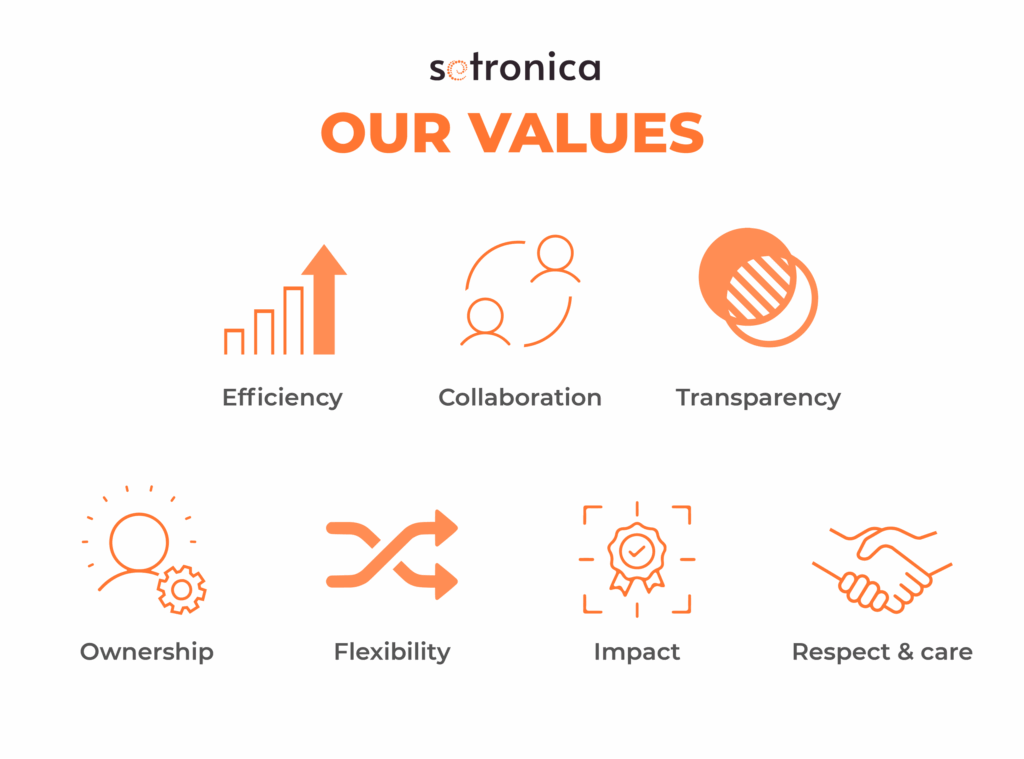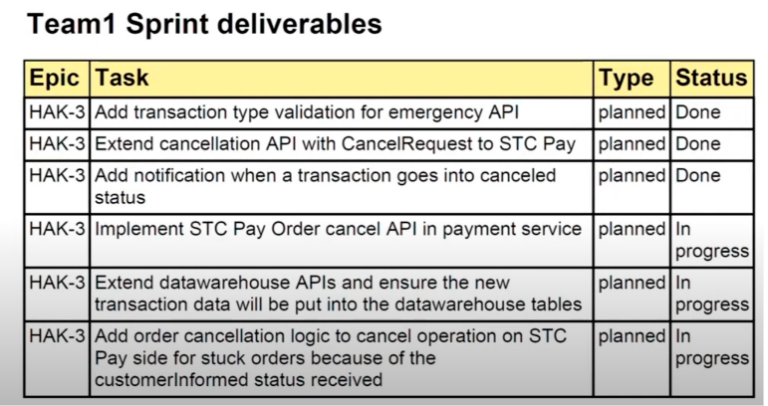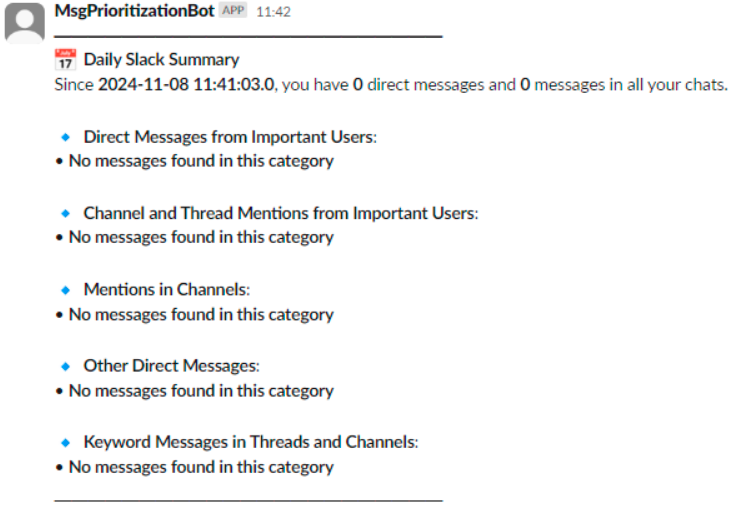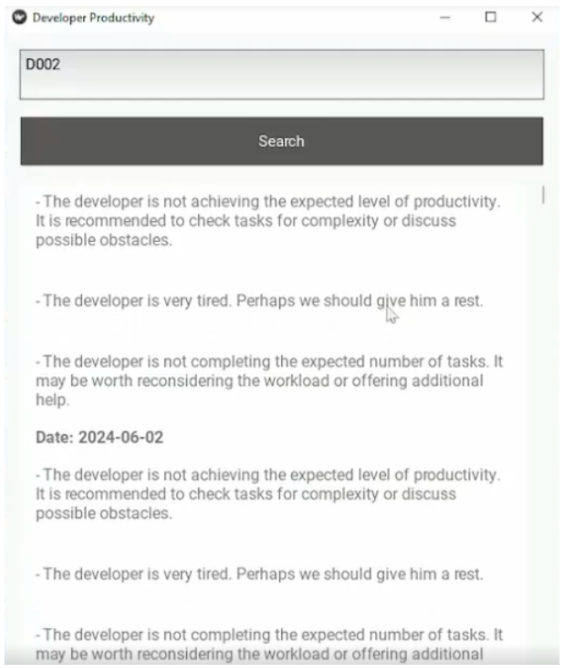 Back to all articles
Back to all articles About a month ago, we launched our very own remote hackathon. Any Setronica developer regardless of their experience, position, or specialization could take part in it. What counted was the ideas and determination.
We had a clear goal for the hackathon: to make a space where new ideas could grow freely, without the usual daily limits. By squeezing the whole process of coming up with new things into just 8 hours, we wanted to quickly create and test new ideas. We also hoped this would help find solutions for improving our efficiency and workflow.
The hackathon beautifully aligned with Setronica’s core values, bringing them to life in a dynamic, collaborative environment.

These are the values we develop within our team
We mixed our company values with the hackathon’s goals. This created a great environment for new ideas. It also made our team closer and showed we want to keep getting better and adapting.
It all started with several project managers who had proposals on automating routine things. From an AI scheduling assistant to automated sprint summaries – the management team was buzzing with the ideas.
Finally, we settled on three tasks that had more value to Setronica as a company, and will cover most of the project managers’ needs.
While the tasks were completely different, they had something in common: the solutions presented should have been easily integrated with internal tools like Jira and Slack, and include customization options.
“Imagine a client’s project where several large teams deliver immense value. At the end of each sprint, the manager needs to quickly compile the results, create a presentation, and send it to the client so they can see the accomplishments and progress,” says Denis, project manager and the task owner.
This task required the creation of a bot that could filter sprint tasks by teams, organize them into a structured report, and provide a brief summary of the business value each team contributes.
Another project manager, had a different idea in mind: “I want a system that selects and prioritizes messages from all Slack Organizations that require my immediate attention, allowing me to focus on high-priority communications and ensure timely responses.”
The features of this potential bot should have included certain rules on prioritizing messages, threads, and channels.
Project manager Anastasia believes AI can also play a huge role in making the company culture more eco-friendly:
“Team results often depend on participants’ well-being. Won’t it be nice to have an AI bot to analyze your work volume, meeting schedules, and vacations to evaluate your mood?” she says.
By the beginning of the hackathon, Setronica’s participants grouped into 3 teams so that each team had one challenge to tackle.
Team members brought together diverse skill sets and perspectives. If all of this were offline, you could have sensed the air buzz with animated discussions as participants brainstormed ideas.

These were the online tools that worked perfectly for the hackathon
Fingers flew across keyboards, whiteboards filled up with diagrams and flowcharts.
“I believed that we had done everything right at each of the preparatory stages of the event, which meant everything would work out. But the Hackathon day itself remained a surprise for me,” shares Dima, the hackathon moderator.
As the hours ticked by, challenges inevitably arose. One team needed access to AWS Lambda for convenient code execution. Two tasks required a connection with Jira – in the first one, the task author created a ‘data dummy,’ and in the second case, the team simulated a database.
This put some pressure on the organizational team as they have to react to every question or issue, provide timely access to services, and facilitating the sprint all along.
Andrea, one of the hackathon participants, says the most challenging aspect was ensuring seamless integration with Jira, particularly handling data filtering and categorization for different teams and sprints. “Despite the fact we had different opinions and ideas,” she adds, “we quickly aligned and set our goal.”
Task hosts had their own struggles. “As a project manager, I watched my team from the sidelines, feeling a mix of pride and frustration. I desperately wanted to jump in and lend a hand, but I couldn’t. It felt strange to be unable to help at all,” says she. “So, I did the only thing I could – I cheered them on with all my heart! I felt incredibly proud to work with such amazing people. They were fearless in trying new things and eager to grow their skills across different areas. Seeing their enthusiasm and willingness to learn made me truly happy.”
As the 8-hour mark approached, a flurry of activity ensued. Teams put the finishing touches on their projects and prepared their presentations. The showcase began with each team given a strict 3-minute slot to demo their creation and field questions from judges and peers.
The creativity and technical prowess on display were nothing short of impressive, especially considering the time constraint.
The first team created The Sprint Summary Maker. Its goal is to generate clear, presentation-ready summaries of tasks and features completed during a sprint. It integrates with Jira and categorizes tasks as either planned or expedited, helping managers save time and focus on key achievements.

Prototype of the Sprint Summary Maker
The solution uses Jira for data integration and employs tools such as Google Slides, PPT, or
PDF generators for report creation. Automation scripts are written in JavaScript, and the team also used Node.js/Express for the server-side, along with HTML/CSS for the frontend.
Andrea, one of the developers in the project, says she was excited to revisit the fundamentals and experience group work. “I prepared the server for our web page and fixed the frontend API calls. Igor set the plan at the beginning and developed/tested the API methods, while Nik handled the report generation.”
The task host’s reaction was nothing but praise: “The team tackled the task immediately and cohesively,” says Dennis, “I didn’t expect this project could be implemented in a day, but the team managed it. I believe the team has accomplished the task brilliantly!”
The second team tackled the challenge of automating Slack messages prioritization. “Slack Highlighter checks for important messages within Slack and sends them to a designated channel on a selected schedule,” explains Tilen, one of the creators behind the project. “It’s a lightweight bot within Slack, written in Java.”
The team shares the most challenging aspect was the time limit, along with gaining access to the server. However, all of this was worth it when they saw the bot worked as planned after all their efforts.

Prototype of Slack Highlighter
“For now, our cute bot isn’t ready to go public yet, but it EXISTS! And I’m sure the team has the power to bring it to perfection!” Project manager exclaims, eager to use this bot for sorting the heap of Slack messages.
The Wellbeing Analyzer created by the third team caused a lot of buzz and positive reactions from project managers and the HR department.

Wellbeing Analyzer prototype
“By leveraging data on tasks, we can identify trends and patterns that can be used to improve team performance. We aim to understand how workload affects individual performance and to identify potential areas for improvement,” that’s how the team presented the project.
The team used KivyMD for creating the interface and data visualization, as well as Python for developing performance calculation algorithms and data analysis. They also used ijson for processing JSON files containing information about developers’ tasks.
“The best idea was to implement developer search through the interface rather than text input. This significantly improved the user experience,” shares George, one of those who worked on the analyzer.
As the dust settled on Setronica’s first 8-hour hackathon, the impact was undeniable. Beyond the impressive prototypes developed, the event fostered a renewed sense of camaraderie and innovation within the company.
“Solving 2 out of 3 tasks in a day is a success. And we will finalize the third task as part of our regular work, as it is interesting for the company from the perspective of AI experiments.”
Dima, the hackathon moderator, concludes
The general feeling from the participants was they’ve rapidly enhanced their skills on particular subjects or revisited some topics they’ve been neglecting for some time.
“The hackathon gave me an opportunity to delve deeper into working with KivyMD and expand my skills in developing analytical applications. I also improved my knowledge of working with large JSON files,” says George. “And most importantly, I gained valuable experience working in a team – this was the most crucial aspect of this hackathon for me.”
The sense of teamwork was the second-popular factor mentioned in the post-hackathon interviews.
“Teamwork went smoothly, with responsibilities distributed according to each participant’s skills,” says Max. “The challenging part was creating balanced and realistic data for employees with varying productivity levels. We needed to consider parameters of stable performance for one employee and deteriorating indicators for another.”
Participants received a surprise gift: the choice of Udemy courses. This added excitement to the hackathon, which already showcased skills and innovation. The courses offered a chance to improve expertise or explore new tech areas. This reward highlighted the organizers’ commitment to nurturing talent and promoting ongoing learning, extending the event’s impact beyond its duration.
Looking ahead, Setronica considers making the hackathon an annual event. We are also exploring ways to integrate the rapid ideation and prototyping techniques used during the hackathon into our regular development processes.
The hackathon proved that sometimes, the most innovative solutions come not from months of planning, but from a focused burst of creativity and collaboration. The spirit of the hackathon will undoubtedly continue to influence our approach to problem-solving and innovation.





